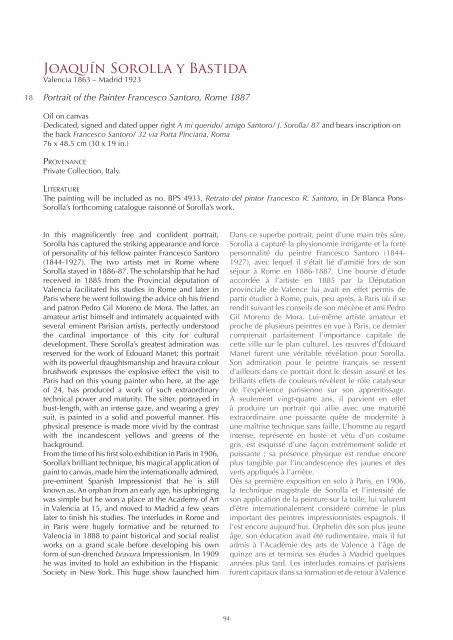XVII - Master Paintings - Jean Luc Baroni and Marty de Cambiaire
Create successful ePaper yourself
Turn your PDF publications into a flip-book with our unique Google optimized e-Paper software.
Joaquín Sorolla y Bastida<br />
Valencia 1863 – Madrid 1923<br />
18<br />
Portrait of the Painter Francesco Santoro, Rome 1887<br />
Oil on canvas<br />
Dedicated, signed <strong>and</strong> dated upper right A mi querido/ amigo Santoro/ J. Sorolla/ 87 <strong>and</strong> bears inscription on<br />
the back Francesco Santoro/ 32 via Porta Pinciana, Roma<br />
76 x 48.5 cm (30 x 19 in.)<br />
Provenance<br />
Private Collection, Italy.<br />
Literature<br />
The painting will be inclu<strong>de</strong>d as no. BPS 4933, Retrato <strong>de</strong>l pintor Francesco R. Santoro, in Dr Blanca Pons-<br />
Sorolla’s forthcoming catalogue raisonné of Sorolla’s work.<br />
In this magnificently free <strong>and</strong> confi<strong>de</strong>nt portrait,<br />
Sorolla has captured the striking appearance <strong>and</strong> force<br />
of personality of his fellow painter Francesco Santoro<br />
(1844-1927). The two artists met in Rome where<br />
Sorolla stayed in 1886-87. The scholarship that he had<br />
received in 1885 from the Provincial <strong>de</strong>putation of<br />
Valencia facilitated his studies in Rome <strong>and</strong> later in<br />
Paris where he went following the advice oh his friend<br />
<strong>and</strong> patron Pedro Gil Moreno <strong>de</strong> Mora. The latter, an<br />
amateur artist himself <strong>and</strong> intimately acquainted with<br />
several eminent Parisian artists, perfectly un<strong>de</strong>rstood<br />
the cardinal importance of this city for cultural<br />
<strong>de</strong>velopment. There Sorolla’s greatest admiration was<br />
reserved for the work of Edouard Manet; this portrait<br />
with its powerful draughtsmanship <strong>and</strong> bravura colour<br />
brushwork expresses the explosive effect the visit to<br />
Paris had on this young painter who here, at the age<br />
of 24, has produced a work of such extraordinary<br />
technical power <strong>and</strong> maturity. The sitter, portrayed in<br />
bust-length, with an intense gaze, <strong>and</strong> wearing a grey<br />
suit, is painted in a solid <strong>and</strong> powerful manner. His<br />
physical presence is ma<strong>de</strong> more vivid by the contrast<br />
with the inc<strong>and</strong>escent yellows <strong>and</strong> greens of the<br />
background.<br />
From the time of his first solo exhibition in Paris in 1906,<br />
Sorolla’s brilliant technique, his magical application of<br />
paint to canvas, ma<strong>de</strong> him the internationally admired,<br />
pre-eminent Spanish Impressionist that he is still<br />
known as. An orphan from an early age, his upbringing<br />
was simple but he won a place at the Aca<strong>de</strong>my of Art<br />
in Valencia at 15, <strong>and</strong> moved to Madrid a few years<br />
later to finish his studies. The interlu<strong>de</strong>s in Rome <strong>and</strong><br />
in Paris were hugely formative <strong>and</strong> he returned to<br />
Valencia in 1888 to paint historical <strong>and</strong> social realist<br />
works on a gr<strong>and</strong> scale before <strong>de</strong>veloping his own<br />
form of sun-drenched bravura Impressionism. In 1909<br />
he was invited to hold an exhibition in the Hispanic<br />
Society in New York. This huge show launched him<br />
Dans ce superbe portrait, peint d’une main très sûre,<br />
Sorolla a capturé la physionomie intrigante et la forte<br />
personnalité du peintre Francesco Santoro (1844-<br />
1927), avec lequel il s’était lié d’amitié lors <strong>de</strong> son<br />
séjour à Rome en 1886-1887. Une bourse d’étu<strong>de</strong><br />
accordée à l’artiste en 1885 par la Députation<br />
provinciale <strong>de</strong> Valence lui avait en effet permis <strong>de</strong><br />
partir étudier à Rome, puis, peu après, à Paris où il se<br />
rendit suivant les conseils <strong>de</strong> son mécène et ami Pedro<br />
Gil Moreno <strong>de</strong> Mora. Lui-même artiste amateur et<br />
proche <strong>de</strong> plusieurs peintres en vue à Paris, ce <strong>de</strong>rnier<br />
comprenait parfaitement l’importance capitale <strong>de</strong><br />
cette ville sur le plan culturel. Les œuvres d’Édouard<br />
Manet furent une véritable révélation pour Sorolla.<br />
Son admiration pour le peintre français se ressent<br />
d’ailleurs dans ce portrait dont le <strong>de</strong>ssin assuré et les<br />
brillants effets <strong>de</strong> couleurs révèlent le rôle catalyseur<br />
<strong>de</strong> l’expérience parisienne sur son apprentissage.<br />
À seulement vingt-quatre ans, il parvient en effet<br />
à produire un portrait qui allie avec une maturité<br />
extraordinaire une puissante quête <strong>de</strong> mo<strong>de</strong>rnité à<br />
une maîtrise technique sans faille. L’homme au regard<br />
intense, représenté en buste et vêtu d’un costume<br />
gris, est esquissé d’une façon extrêmement soli<strong>de</strong> et<br />
puissante ; sa présence physique est rendue encore<br />
plus tangible par l’inc<strong>and</strong>escence <strong>de</strong>s jaunes et <strong>de</strong>s<br />
verts appliqués à l’arrière.<br />
Dès sa première exposition en solo à Paris, en 1906,<br />
la technique magistrale <strong>de</strong> Sorolla et l’intensité <strong>de</strong><br />
son application <strong>de</strong> la peinture sur la toile, lui valurent<br />
d’être internationalement considéré comme le plus<br />
important <strong>de</strong>s peintres impressionnistes espagnols. Il<br />
l’est encore aujourd’hui. Orphelin dès son plus jeune<br />
âge, son éducation avait été rudimentaire, mais il fut<br />
admis à l’Académie <strong>de</strong>s arts <strong>de</strong> Valence à l’âge <strong>de</strong><br />
quinze ans et termina ses étu<strong>de</strong>s à Madrid quelques<br />
années plus tard. Les interlu<strong>de</strong>s romains et parisiens<br />
furent capitaux dans sa formation et <strong>de</strong> retour à Valence<br />
94















